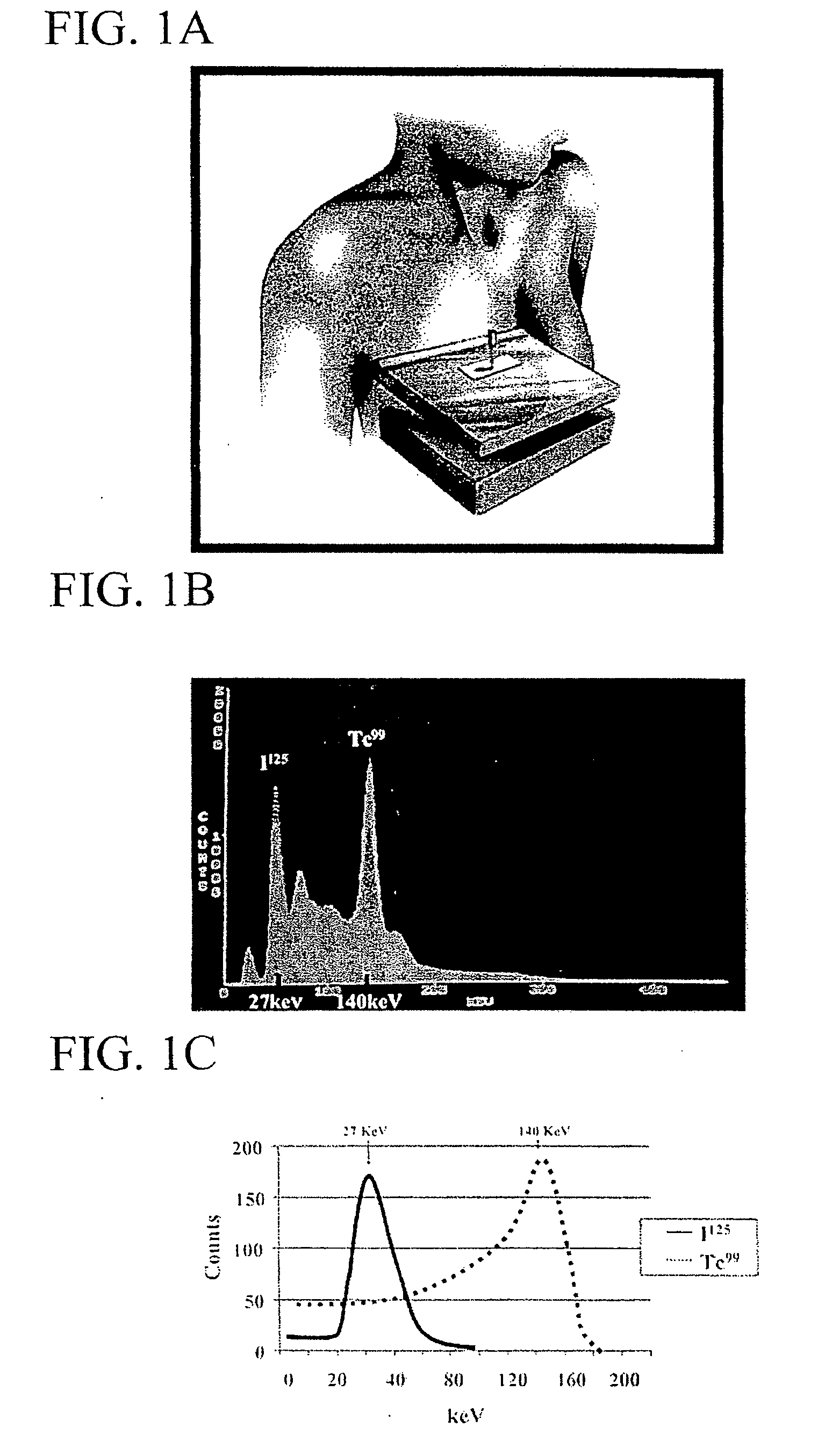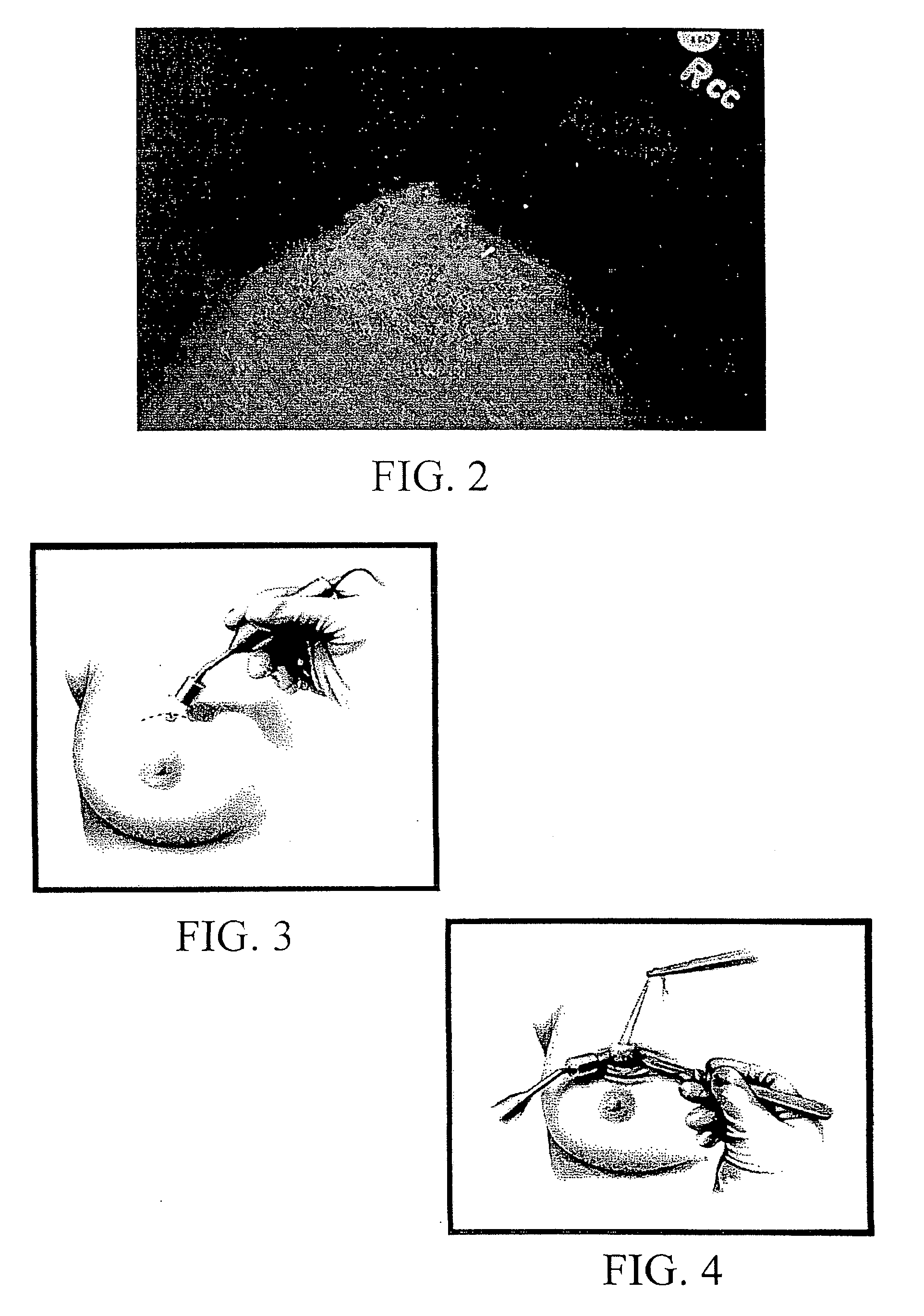Radio guided seed localization of imaged lesions
a radioguided, imaged technology, applied in radiation therapy, therapy, etc., can solve the problems of difficult current methods of breast cancer treatment with radioactive seed deployment, and achieve the effect of easy transportability and minimal or no migration
- Summary
- Abstract
- Description
- Claims
- Application Information
AI Technical Summary
Benefits of technology
Problems solved by technology
Method used
Image
Examples
example1
[0107] Mammographic placement of a single 125-I seed by the radiologist is performed. Once the patient is placed in the mammographic device and the location of the lesion is determined, the skin is cleansed. Local anesthetic is injected at the site of the placement. An 18-gauge needle with sterile bone wax occluding the tip is loaded with a single 125-I seed. The needle is placed into the breast tissue under mammographic guidance to the suspicious lesion. A stilette is placed into the bore of the needle displacing the seed through the tip. The needle and stilette apparatus are removed from the breast tissue. The seed location is confirmed to be at the lesion with mammography and films are taken. The patient is then taken to the operating room.
[0108] The patient is prepared and draped in the normal sterile fashion. A sterile sleeve is placed over a Neoprobe™ Gamma counter. A hand-held probe, which is properly windowed and calibrated to detect I125, is then run across the skin surfac...
example 2
[0112] Needle localized breast biopsy (NLBBx) has been the standard for diagnosis of nonpalpable lesions for the past 20 years. Low dose radioactive seed localization (RSL) can be used in conjunction with a hand held gamma detector (HHGD) to localize nonpalpable breast lesions and accurately remove the radiographic lesion with reduced operative time (OT) and-tissue volume (TV).
Methods
[0113] A titanium seed containing 0.05-0.1 mCi of I125 is placed with mammographic or ultrasound guidance localizing the suspicious breast lesion. The HHGD is used to externally locate the seed. The incision is placed directly over the seed / lesion. The HHGD directs the excision and verifies seed / lesion removal. A specimen radiograph (S-X-ray) was performed to confirm the seed / lesion removal. Variables included OT, TV, surgeon retrieval success (SRS), and pathologist retrieval success (PRS). Success of identification of the seed / lesion by the surgeon and- pathologist were assessed prior to S-X-ray uti...
example 3
Materials and Methods
[0116] Patients were recruited from the Comprehensive Breast Center who had been referred for suspicious mammographically detected lesions requiring NLBB. Variables analyzed included the size and weight of the specimen, total time in the operating room, surgeon retrieval success, and cumulative radiation exposure to the surgeon, radiologist and pathologist.
[0117] The technique involves placing a titanium seed containing 0.05-0.1 mCi of I-125 into an 18-gauge needle with sterile bone wax occluding the tip. The apparatus is placed into the breast parenchyma under radiographic guidance (mammography or ultrasound). A stilette is placed into the needle displacing the seed through the tip localizing the lesion. The seed localization is confirmed to be at the lesion with mammography.
[0118] After surgical preparation, the sterile sheathed HHGD is utilized to identify location of the seed / lesion by counts of radioactivity. After administration of a local anesthetic, ...
PUM
 Login to View More
Login to View More Abstract
Description
Claims
Application Information
 Login to View More
Login to View More - R&D
- Intellectual Property
- Life Sciences
- Materials
- Tech Scout
- Unparalleled Data Quality
- Higher Quality Content
- 60% Fewer Hallucinations
Browse by: Latest US Patents, China's latest patents, Technical Efficacy Thesaurus, Application Domain, Technology Topic, Popular Technical Reports.
© 2025 PatSnap. All rights reserved.Legal|Privacy policy|Modern Slavery Act Transparency Statement|Sitemap|About US| Contact US: help@patsnap.com



